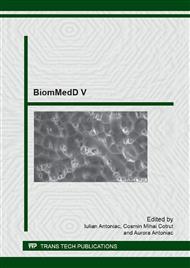p.41
p.47
p.51
p.56
p.67
p.80
p.87
p.91
p.95
New Polyurethane Sealants Containing Rosin for Non-Invasive Disc Regeneration Surgery
Abstract:
Different polyurethane sealants were prepared by reacting methylene dyísocyanate and polyadipate of 1,4 butane diol (Mw : 2500 daltons) by using the prepolymer method and different mixtures of rosin and 1,4 butane diol were used as chain extenders. The polyurethanes were characterized by plate-plate rheology, molecular weight distribution, Differential Scanning Calorimetry (DSC), and Laser Confocal Microscopy. The tack of the polyurethanes sealants was obtained by using a modified probe tack method, and their adhesion was obtained by T-peel test of leather/polyurethane sealant/leather joints and by single lap-shear tests of aluminium/polyurethane sealant/aluminium joints. Depending on the rosin content in the chain extender the structure of the polyurethanes was different, i.e. more urethane and urethane-amide hard segments were created up to 50 eq% rosin in the chain extender, and separation of domains was prevailing in the polyurethanes with higher rosin content. Furthermore, the addition of rosin caused an increase in the length of the polymer chains and in the storage modulus (particularly in the polyurethane containing 50 eq% rosin), and decrease in the melting enthalpy. Moreover, the crystallinity of the polyurethanes containing up to 50 eq% rosin showed lower number and smaller spherulites, Finally, the tack at 37 °C and the peel strength increased in the joints made with the polyurethane sealants containing rosin whereas the adhesive shear strength decreased when the polyurethane sealant contained 50 eq% rosin or less.
Info:
Periodical:
Pages:
67-79
Citation:
Online since:
September 2013
Keywords:
Price:
Сopyright:
© 2014 Trans Tech Publications Ltd. All Rights Reserved
Share:
Citation:


